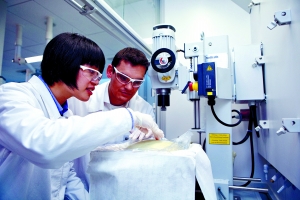Earlier this year, the China Petroleum and Chemical Industry Federation invited executives of 17 multinational corporations such as BASF, Bayer, Celanese, Evonik, Dow Chemical, and Solvay to carry out the development trend of the world's petrochemical industry in the next decade. And China's Innovation and Development Opportunity ". After 9 months of research and compilation, the “Taiwan National Corporation's Future Research Report on China's Petroleum and Chemical Industry†(hereinafter referred to as “Study Reportâ€) was formed.
So, in the eyes of these multinational executives, the future of the global petrochemical industry will show what kind of development trend? Today, the China Chemical News reporter compiled the “research report†in part to compose readers.
One of the trends: The rapid growth and development of the global petrochemical industry will exceed the growth rate of local GDP.
The "Research Report" pointed out that at present, the global economy is entering a new phase of slow growth, but in the long run, the global petrochemical industry will continue to maintain rapid growth. In both developed and developing countries, the petrochemical industry will exceed the growth rate of GDP. In the next decade, the global petrochemical industry will still have more room for growth.
The American Chemical Industry Council (ACC) predicts that the growth rate of the global chemical industry in 2014 will increase to 3.8%, and the growth rate of the US chemical industry after 2015 will reach 4%, which is much higher than the US economic growth expectation. The European Chemical Industry Association also expects that the EU petrochemical industry production will grow by 2%, which is higher than the overall expectation of EU economic growth. IHS predicts that Japan’s GDP will increase by 1.8% in 2014, while chemical production will increase by 4%. The Indian Chemical Council stated in a report that the demand for chemicals in India will be 1.5 times GDP growth. The Brazilian Petrochemical Association stated that if Brazil achieves economic growth of 3%, the demand for petrochemical products will increase by 4% to 5%.
Among these, the performance of emerging economies is particularly dazzling.
According to the forecast of the International Monetary Fund (IMF), the global economy will grow by 3.4% in 2014, and the economic growth rate of emerging and developing economies, including the BRICS countries, will reach 4.6%. The economic growth in Asia will reach 6.4%, which is the fastest growing region in the world economy. This shows that the engine of global economic growth is speeding up the transfer to emerging economies.
In short, the current global economy is entering a new phase of slow growth. However, in the long-term future, the global petrochemical industry will continue to maintain rapid growth. In both developed and developing countries, the petrochemical industry will exceed the growth rate of GDP. The rapid development of emerging economies has provided a powerful driving force and market space for the development of the global petrochemical industry, and has driven the growth of markets from North America and Western Europe to accelerate the transition to high-speed growth in Asia Pacific and South America. In the next decade, the global petrochemical industry will still have more room for growth.
Trend 2: Raw material diversification accelerates major changes in energy structure
The "research report" puts forward three main points:
1. The large-scale development of shale gas promotes the shift of the global oil and gas supply center to the west.
The development of the world's primary energy is entering a new era of “four worlds†in oil, natural gas, coal, and new energy. In the longer term, oil and gas will remain the mainstay of energy consumption. According to the US Energy Information Administration (EIA), in the global primary energy consumption structure in 2040, oil accounts for 28%, natural gas accounts for 23%, coal accounts for 27%, and nuclear energy and renewable energy account for 22%. The North American shale gas revolution is pushing the world's oil and gas industry to leapfrog from conventional oil and gas to unconventional oil and gas.
2. The major breakthroughs in China's modern coal chemical industry have opened up new ways of raw material supply.
The technological breakthrough in modern coal chemical industry has accelerated the process of replacing oil with coal. China is developing demonstration projects for coal to oil, coal to natural gas, and coal to olefins, and some of these projects have achieved good results. It is expected that in the next decade, China's natural gas consumption, imports, and prices will all continue to grow. Coal-based natural gas production costs will remain lower than natural gas import costs. The cost and environmental benefits of West-East Gas Transmission are also better than those of West-to-East coal transport; The V standard will be implemented in 2016, and the coal-based oil products have the advantage of ultra-low sulphur content; similarly, the coal-to-olefins project will maintain a certain competitive advantage in the next 5 to 10 years.
From a longer period of time, the modern coal chemical industry achieves sustained and healthy development, and needs to fully consider the domestic resources and environmental capacity; the modern coal chemical industry also faces competition from other new development resources and raw materials, especially the competition of North American shale gas resources. . China's modern coal chemical industry will become another important branch of the raw material diversification process.
3. Biomass energy and chemical products have broad prospects for development.
In order to reduce the dependence on fossil energy and the emission of carbon dioxide and other greenhouse gases and pollutants, all countries in the world attach great importance to the research, development and utilization of renewable energy. The petrochemical industry mainly includes products such as ethanol gasoline, biodiesel, biochemical raw materials and polymers. Many large multinational petrochemical companies also adjusted their development strategies and actively joined the ranks of related product R&D. At present, 7% to 8% of global chemical products are produced from biomass resources. In the next decade, biomass energy and chemical products will have new breakthroughs in technology, and industrial scale and product output will further increase, becoming one of the raw material sources for the petrochemical industry.
The third trend: High-end, differentiated, in-depth development promotes the industry to continue to the high end of the value chain
Technological innovation has become the main driving force for the transformation and upgrading of the petrochemical industry. The transformation of the structure driven by technological innovation has become the key to seizing the commanding heights of future competition.
New chemical materials will become the fastest growing and most competitive industries. Most multinational corporations regard new chemical materials as the strategic focus of future development and continuously increase their investment in scientific research. Among them, the development and application of high-end chemical new materials with higher value and more outstanding performance have attracted much attention. In particular, biopharmaceuticals, packaging materials, automotive lightweight materials, electronic chemicals, building materials, etc. will accelerate the development of new chemical materials. Market share will expand rapidly.
Emerging information technologies such as the Internet, the Internet of Things, and big data will also be further applied in the petrochemical industry to promote the industry's overall improvement in information and automation. The application of new information technologies can make oil exploration, extraction and transportation more efficient, thereby effectively reducing operating costs. Taking the oil gathering and transportation field as an example, by using the Internet of Things, GPS, GIS, and CMDA/GPRS communication technologies, it is possible to establish information monitoring platforms for drilling, oil pipelines, and tank trucks in the oil industry. Industry field drilling, tank transportation, and oil pipelines are monitored in real time, and the status parameters of each monitoring instrument are collected wirelessly to achieve centralized, efficient, and unified management of resources.
The life science industry will make significant progress. With the rapid growth of the population and the acceleration of aging, people gradually realize that the protection and access to nutrition are crucial to the physical and mental development of the people. Therefore, the demand for safer and healthier foods and drugs will also gradually increase. In the next decade, vigorously developing life sciences is a major strategic goal pursued by global multinational corporations.
Trend No. 4: Safety, Environmental Protection Constrained, Green, and Low-Carbon to Become a New Direction for Industry Development
The "research report" believes that the energy-saving and environmental protection industry will become a new economic growth point. Environmental protection is one of the most arduous and urgent tasks facing the world at present and in the period to come. The petrochemical industry can provide advanced solutions and technical products for energy conservation, emission reduction and environmental protection, whether in traditional waste water, waste residue, or For waste gas and other "three wastes" treatment, the efficiency of energy and resource use will be increased, or carbon dioxide emissions will be reduced and eliminated. The petrochemical industry will show its talents.
All countries in the world are strongly encouraging and supporting the development of energy-saving and environmental protection industries. China has also listed energy-saving and environmental protection industries as strategic emerging industries, giving policy guidance and financial support. Multinational corporations have also taken the environmental protection industry as the focus of long-term development in the future and have taken a pivotal position in the development strategy. For example, focusing on clean water requirements, we will focus on the development of reverse osmosis and ion exchange technologies, research and development of ion exchange resins, adsorbents, and functional polymers; and develop and manufacture new polymer materials to reduce vehicle emissions and energy consumption in light of automotive weight reduction. According to the air pollution brought by automobiles, we will focus on the development of vehicle exhaust catalytic purification systems, including exhaust gas catalytic purification solutions for light-duty vehicles, heavy-duty diesel vehicles, gas locomotives, coal-fired power plants, chemical plants, and gas turbines. Car exhaust gas purification; The world will further increase R&D investment on the basis of already achieved results, carry out carbon dioxide capture, storage, and industrial application of utilization technology, and will achieve greater breakthroughs and progress in the next decade.
Responsible Care will be further promoted globally. Responsible Care is an industry self-regulatory activity carried out in the oil and chemical industry worldwide. It is a new development concept for companies to care for employees, care for the society, and establish their own image. "Responsible Care" has been proposed for more than 20 years and has played an important role in promoting enterprises to strengthen safety management and enhance the level of intrinsic safety. It has been widely recognized by the world's counterparts. Since 1992, the International Federation of Chemical Industry Associations has promoted Responsible Care globally, and it has been joined by more than 50 countries.
In the next decade, more countries and regions and petrochemical companies will commit to implementing responsible care. In particular, developing countries will actively implement responsible care in order to change their image and achieve sustainable development. The level of intrinsic safety of the petrochemical industry will be Will greatly improve.
Trend 5: Globalization and Regional Trade Intertwined to Further Increase the Uncertainty of International Trade Development
The "research report" considers:
1. The integration of global economic integration and regional trade facilitation
According to the forecast of the International Monetary Fund (IMF), the growth rate of global trade scale will increase from 2.7% in the past few years to 4.5% in 2014 and 5.2% in 2015. Global foreign direct investment (FDI) traffic increased by 11% in 2013, among which FDI flows to developing countries accounted for record highs. However, due to the complexity of the world economy and trade, the slow progress of the WTO negotiations has limited the ability of the WTO to formulate a global free trade rule. Therefore, the development of regional free trade negotiations and the promotion of regional trade liberalization and economic integration have become the development of all countries in the world. inevitable choice. The content of regional free trade agreements generally includes zero tariffs, liberalization of trade in goods and services, elimination of technical trade barriers, protection of intellectual property rights and other policies that stimulate the healthy development of the regional economy. Regional trade agreements will promote trade and investment among the economies in the region. They are very beneficial to the development of the petrochemical industry in various countries in the region, but countries outside the region cannot enjoy the positive economic effects of mutual promotion between countries and increase global petrochemical trade. Uncertainty. It is expected that in the next ten years, the regional scope of the free trade zone will continue to expand, the process of regional trade integration based on the free trade zone will also accelerate, the scale of global trade and investment will continue to grow, and developing countries will play a more important role. The status.
2. Technical barriers to trade create new barriers to international trade
With the deepening of the process of economic integration and trade liberalization, traditional trade barriers such as tariffs and licenses have been greatly weakened, but various forms of non-tariff trade barriers are gradually being formed. At the same time, countries have increased their environmental protection. Many of the terms and requirements have brought challenges to the global chemical trade in the future.
Globally, the Global Harmonized System of Classification and Labelling of Chemicals (GHS) and Chemical Safety Data Sheet (MSDS) are currently the main systems for the effective management of world chemicals production and trade, but due to the existence of regional and national Due to differences in development and institutional differences, many regions and countries have formulated their own chemical management policies and regulations. For example, the European Union's REACH Regulations, the United States' Toxic Substances Management Act (TSCA), Japan's Chemical Review Act CSCL) and Security and Safety Act (ISHL), Korea's Toxic Chemicals Control Act (TCCL), Industrial Safety and Health Act (ISHL ), China's hazardous chemicals regulations and registration of new chemical substances.
In the long run, it is a common consensus that the global community further strengthens the supervision of chemicals. Effective and uniform chemical supervision in the world is an inevitable trend for future development. However, some countries and regions have also increased their “green barriers†to environmental protection issues while strengthening chemical supervision. Many trade protectionism with green development as their frontiers is on the rise, increasing the cost of corporate trade, and the international trade of petrochemical products has been affected. Big impact. In addition, the global carbon emission reduction and carbon trading activities with the main goal of coping with global warming are becoming increasingly active, and they are becoming a unified understanding of the countries around the world. However, this has also brought enormous energy-saving and emission-reducing pressures to the petrochemical industry. These technical trade barriers have greatly increased the uncertainty of international trade and become a constraint to the development of international petrochemical products trade.

â–²Environmental pressure is a challenge for the future development of petrochemical companies. More and more multinational companies are committed to building environmentally friendly companies. Ashland has adopted green land in Changzhou for 10 years.

â–² Researchers at BASF's Asia Pacific Innovation Park are testing new materials.

The picture shows the flame-retardant green foam board developed by Albemarle.

▲ SABIC's research and development of plates are paved in the stadium with an area of ​​12,900 square meters of pavilion roof and lighting. This is an extremely durable, light-weight, impact-resistant, fire-resistant and UV-resistant monolith that not only provides viewers with Pleasant viewing experience, while also protecting them from unpredictable weather conditions.